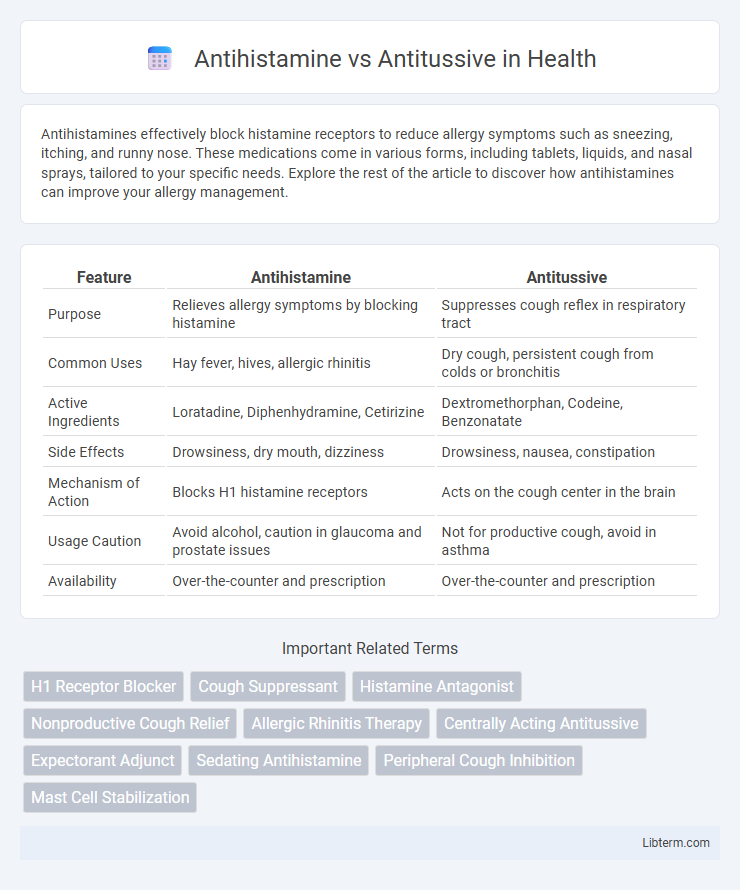Antihistamines effectively block histamine receptors to reduce allergy symptoms such as sneezing, itching, and runny nose. These medications come in various forms, including tablets, liquids, and nasal sprays, tailored to your specific needs. Explore the rest of the article to discover how antihistamines can improve your allergy management.
Table of Comparison
| Feature | Antihistamine | Antitussive |
|---|---|---|
| Purpose | Relieves allergy symptoms by blocking histamine | Suppresses cough reflex in respiratory tract |
| Common Uses | Hay fever, hives, allergic rhinitis | Dry cough, persistent cough from colds or bronchitis |
| Active Ingredients | Loratadine, Diphenhydramine, Cetirizine | Dextromethorphan, Codeine, Benzonatate |
| Side Effects | Drowsiness, dry mouth, dizziness | Drowsiness, nausea, constipation |
| Mechanism of Action | Blocks H1 histamine receptors | Acts on the cough center in the brain |
| Usage Caution | Avoid alcohol, caution in glaucoma and prostate issues | Not for productive cough, avoid in asthma |
| Availability | Over-the-counter and prescription | Over-the-counter and prescription |
Introduction to Antihistamines and Antitussives
Antihistamines are medications that block histamine receptors to alleviate allergic reactions, including symptoms like runny nose, itching, and hives. Antitussives suppress the cough reflex, targeting the central nervous system to reduce persistent or dry coughs. Both drug classes provide symptomatic relief but address distinct mechanisms in respiratory and allergic conditions.
Understanding Antihistamines: Mechanism and Uses
Antihistamines function by blocking histamine H1 receptors, reducing allergic symptoms such as sneezing, itching, and nasal congestion. They are primarily used to treat allergic reactions, including hay fever, urticaria, and anaphylaxis, by preventing histamine-induced inflammation. Unlike antitussives, which suppress cough reflexes, antihistamines target the immune response to allergens, providing relief from allergic conditions rather than cough suppression.
Antitussives Explained: How They Work
Antitussives suppress the cough reflex by acting on the brain's cough center or by coating the throat to reduce irritation. Common active ingredients in antitussive medications include dextromethorphan and codeine, which help alleviate persistent coughing without addressing underlying causes. Unlike antihistamines, which block histamine receptors to reduce allergic symptoms, antitussives primarily target neurological pathways to control cough frequency and intensity.
Key Differences Between Antihistamines and Antitussives
Antihistamines primarily block histamine receptors to reduce allergy symptoms such as itching, sneezing, and runny nose, while antitussives suppress the cough reflex to relieve coughing. Antihistamines target allergic reactions and are commonly used in conditions like hay fever and urticaria, whereas antitussives are used in managing coughs caused by colds or respiratory infections. These medications differ in their mechanism of action, therapeutic purpose, and symptom relief focus, making them distinct treatment options for separate conditions.
Common Medical Conditions Treated
Antihistamines are primarily used to treat allergic conditions such as hay fever, urticaria, and allergic rhinitis by blocking histamine receptors, reducing symptoms like sneezing, itching, and runny nose. Antitussives are specifically designed to suppress cough caused by colds, bronchitis, and other respiratory infections by acting on the cough center in the brain or locally soothing irritated airways. Both medications address distinct symptoms: antihistamines target allergic reactions, while antitussives manage cough associated with respiratory tract irritation.
Side Effects and Safety Profiles
Antihistamines often cause drowsiness, dry mouth, and dizziness due to their sedative effects, with first-generation types posing higher risks compared to second-generation variants that have improved safety profiles. Antitussives can lead to side effects such as nausea, dizziness, and potential respiratory depression, especially with opioid-based formulations, making cautious use essential. Both drug classes require attention to patient-specific factors like age, pre-existing conditions, and potential drug interactions to ensure safe administration.
Over-the-Counter vs Prescription Medications
Antihistamines and antitussives serve different purposes in treating allergies and coughs, with both available as over-the-counter (OTC) and prescription medications. OTC antihistamines, such as loratadine and diphenhydramine, primarily relieve allergic symptoms by blocking histamine receptors, whereas prescription antihistamines may target more severe or chronic allergies. Antitussives like dextromethorphan are widely accessible OTC for suppressing coughs, while prescription options such as codeine-based formulations are reserved for more persistent or severe cases, requiring medical supervision due to potential side effects and dependency risks.
Choosing the Right Medication: Factors to Consider
When choosing between antihistamines and antitussives, consider the primary symptoms: antihistamines target allergic reactions such as sneezing, runny nose, and itching by blocking histamine receptors, while antitussives suppress coughing by acting on the cough center in the brain. Patient-specific factors like underlying conditions, age, and potential drug interactions influence the decision, as antihistamines may cause drowsiness and antitussives can have varying side effects depending on their active ingredients. Evaluating symptom severity and treatment goals ensures selection of the most effective and safe medication for managing allergic or cough-related symptoms.
Integrating Antihistamines and Antitussives: Safe Practice
Integrating antihistamines and antitussives requires careful consideration of their pharmacological effects to ensure safe practice and avoid adverse reactions such as excessive sedation or respiratory depression. Clinicians should evaluate patient-specific factors including allergy severity, cough etiology, and potential drug interactions when co-administering these agents. Monitoring for synergistic side effects and adjusting dosages accordingly maximizes therapeutic benefits while minimizing risk.
Conclusion: Making Informed Choices for Symptom Relief
Selecting between antihistamines and antitussives depends on the specific symptoms being treated, as antihistamines alleviate allergy-related issues by blocking histamine receptors, while antitussives suppress cough reflexes to reduce persistent coughing. Understanding the underlying cause of symptoms ensures effective and targeted relief, minimizing unnecessary medication use and potential side effects. Consulting healthcare professionals aids in making informed decisions, optimizing treatment outcomes for conditions like allergies, colds, or respiratory infections.
Antihistamine Infographic

 libterm.com
libterm.com